How to Dehydrate Zoodles & Other Vegetable Noodles
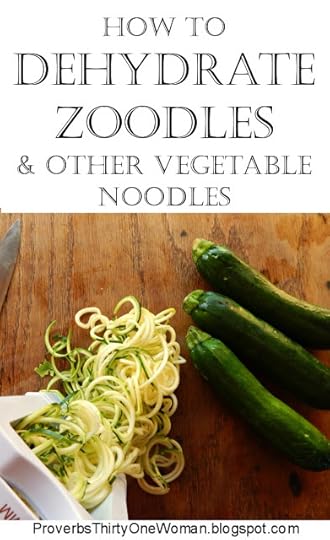 This post contains affiliate links. All opinions are my own. Please see FCC disclosure for full information. Thank you for supporting this site!
This post contains affiliate links. All opinions are my own. Please see FCC disclosure for full information. Thank you for supporting this site!
In case you haven't noticed, zoodles (a.k.a. zucchini "noodles") and other vegetable "noodles" are all the rage right now. Vegetable noodle makers (called spiralizers) are huge sellers on Amazon and big box stores, and you can even buy pre-cut vegetable noodles in the frozen food section of grocery stores. There's no doubt veggie noodles are easy to make and a healthier option than traditional noodles. But did you know you can preserve them for your pantry? Oh yeah.
First: How to Make Zoodles and Other Vegetable Noodles
Years ago, before I'd even heard of a zoodle, I exchanged traditional lasagna noodles for thinly sliced zucchini. All you need to make these is a sharp knife and a steady hand. (Slice 'em thin!) But for spaghetti-like "noodles," which is what most people mean when they talk about zoodles or veggie noodles, it's really best to use a vegetable spiralizer. There are about a gazillion of them on the market, but here's the one I have, and it works very well.
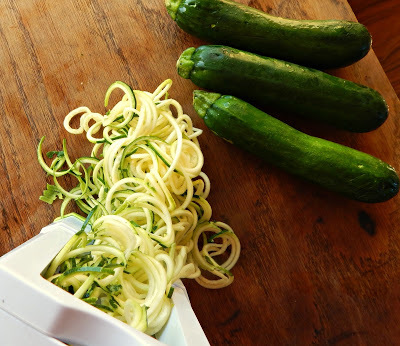 Making zoodles with a vegetable spiralizer.Basically, you just stick washed veggies in the spiralizer and crank the machine. Out come spaghetti-like "noodles," leaving just the core of the veggie as waste. (But as homesteaders, we know this won't go to waste! It will go in the compost bin, or we'll give it to the chickens or pigs or dogs.) And ta-da! You have zoodles.
Making zoodles with a vegetable spiralizer.Basically, you just stick washed veggies in the spiralizer and crank the machine. Out come spaghetti-like "noodles," leaving just the core of the veggie as waste. (But as homesteaders, we know this won't go to waste! It will go in the compost bin, or we'll give it to the chickens or pigs or dogs.) And ta-da! You have zoodles.One word of caution, though. Zucchini is, unfortunately, one vegetable that can be GMO. If you wish to avoid that, you have a few options. You can either buy organic zucchini from the grocery store (legally, organic veggies can't be GMO), or you can buy from a trusted local farmer, or you can grow zucchini yourself. I recommend the later, because zucchini is super-easy to grow, and there are varieties that are appropriate even for the smallest garden spots.
In addition to hand cutting or using a vegetable spiralizer, you could use a julienne peeler to create your zoodles. However, peelers often make zoodles that are quite thin - and thin zoodles dehydrate into almost nothing, which means you may end up with mush when you rehydrate them.
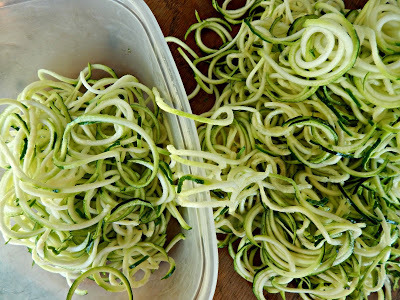 Zoodles store well in a food storage container in the fridge.
Zoodles store well in a food storage container in the fridge.Once you've made your zoodles, the next step is to either eat them fresh (read tips for cooking zoodles here) or store them. They store surprisingly well in a covered food container in the fridge. I've had them last more than a week this way. But for longer term storage, dehydration is your friend.
Dehydrating Zoodles & Other Vegetable Noodles
The trick to dehydrating zoodles effectively is to put them on your food dehydrator's trays in little "nests." This makes them easy to get on the trays, and easy to store, too. (If you've simply sliced zucchini into lasagna-noodle style strips, just lay them flat on your dehydrator's trays, making sure they don't touch.)
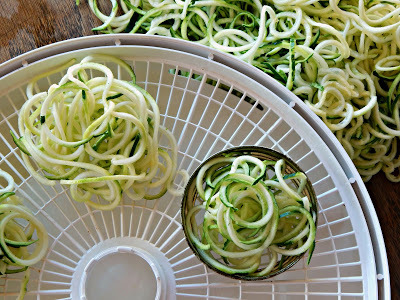 Zoodles dry best when formed into "nests."
Zoodles dry best when formed into "nests."
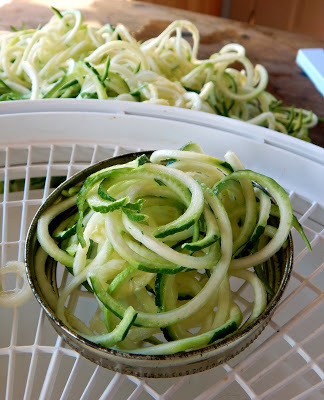 I use a wide mouth canning jar ring to make "nests."To help determine how big the nests should be, I use a wide mouth canning jar ring as a sort of template. This ensures the finished product stores easily in a jar - and keeps me from making the nests so big they take forever to dry. I place the ring on the dehydrator tray, add some zoodles, then remove the ring. If you make the nests too tall, they may impede putting additional trays on your dehydrator. Also, be sure the nests don't touch, or they'll end up sticking together.
I use a wide mouth canning jar ring to make "nests."To help determine how big the nests should be, I use a wide mouth canning jar ring as a sort of template. This ensures the finished product stores easily in a jar - and keeps me from making the nests so big they take forever to dry. I place the ring on the dehydrator tray, add some zoodles, then remove the ring. If you make the nests too tall, they may impede putting additional trays on your dehydrator. Also, be sure the nests don't touch, or they'll end up sticking together.Set the dehydrator at 135 degrees F. and dry until the zoodles are entirely crisp. To test for doneness, break a zoodle. No moisture should come from the break.
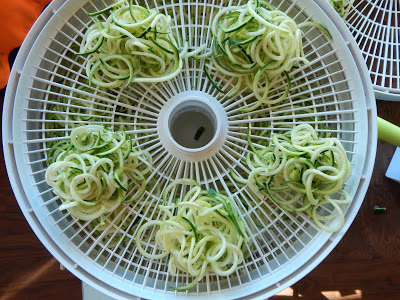 Don't let the "nests" touch, or they will stick together.To store the dehydrated zoodles, place them in a wide mouth canning jar and secure the lid. Store in a dry, dark location. Dried zoodles last at least a year in storage. If you live in a moist or humid area, I suggest adding a desiccant pack to each jar, to help prevent the zoodles from rehydrating while in storage. (Zucchini are particularly prone to this problem.)
Don't let the "nests" touch, or they will stick together.To store the dehydrated zoodles, place them in a wide mouth canning jar and secure the lid. Store in a dry, dark location. Dried zoodles last at least a year in storage. If you live in a moist or humid area, I suggest adding a desiccant pack to each jar, to help prevent the zoodles from rehydrating while in storage. (Zucchini are particularly prone to this problem.)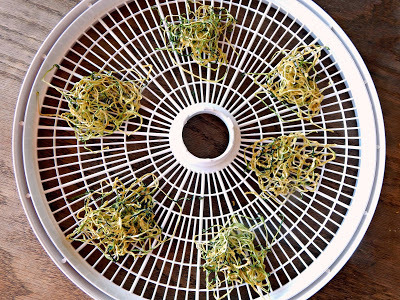 Zoodles shrink considerably when dehydrated.
Zoodles shrink considerably when dehydrated.
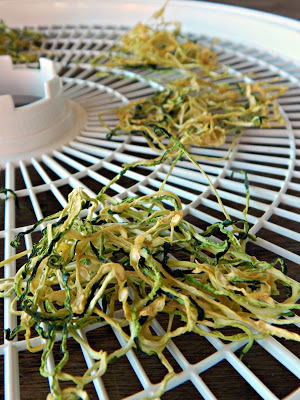 The zoodles are done when they are crisp.
The zoodles are done when they are crisp.
 Store dehydrated zoodles in an airtight jar.To use the zoodles, you may toss them, dry, into soups, stews, or heated pasta sauce. There's no need to rehydrate with water, under these circumstances. If you want to add zoodles to, say, a stir-fry, you'll need to first soak them in a little water. Another option is to boil dried zoodles for about 3 minutes; some people feel this makes them more like traditional pasta. Or simply cover dried zoodles with boiling water, place a lid over the bowl, and let the zoodles sit for about 15 minutes, or until tender. In the three later cases, be sure to squeeze the rehydrated zoodles before adding them to the pan, or the end result will be quite watery.
Store dehydrated zoodles in an airtight jar.To use the zoodles, you may toss them, dry, into soups, stews, or heated pasta sauce. There's no need to rehydrate with water, under these circumstances. If you want to add zoodles to, say, a stir-fry, you'll need to first soak them in a little water. Another option is to boil dried zoodles for about 3 minutes; some people feel this makes them more like traditional pasta. Or simply cover dried zoodles with boiling water, place a lid over the bowl, and let the zoodles sit for about 15 minutes, or until tender. In the three later cases, be sure to squeeze the rehydrated zoodles before adding them to the pan, or the end result will be quite watery.
Published on March 06, 2018 18:47
No comments have been added yet.



